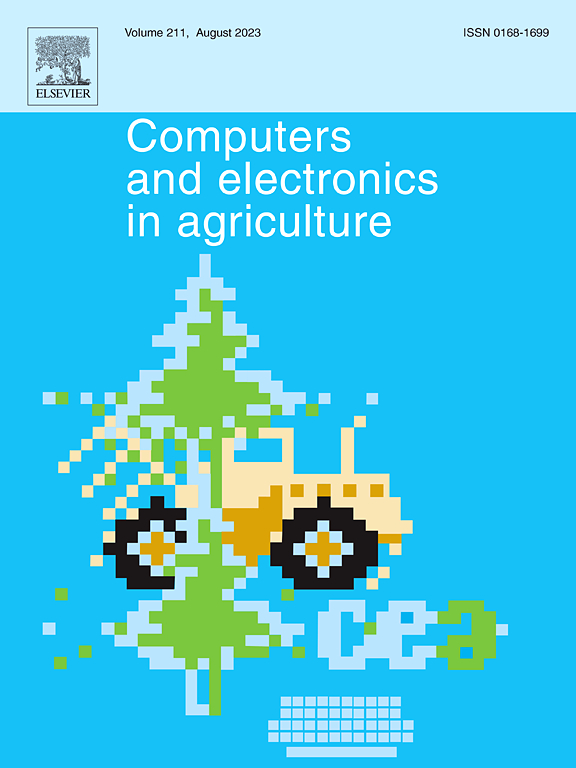基于高效包膜卷积洗牌注意网络的多叶病害识别与分类
IF 8.9
1区 农林科学
Q1 AGRICULTURE, MULTIDISCIPLINARY
引用次数: 0
摘要
植物病害对全球食品安全和农业可持续性构成严重风险,导致收获和质量的重大损失。对于采用有效的控制程序、减少经济损失和确认粮食可及性,需要对这些病毒进行精确和适当的研究。然而,目前的检测方法经常受到限制,例如在不同作物之间的通用性不足,难以处理复杂和嘈杂的背景,以及在处理不同和重叠的疾病症状时表现不佳。这项研究是由解决这些问题的持续必要性驱动的,并提供了一种新的方法来提高疾病识别和分类性能。针对这一需求,我们提出了高效胶囊卷积洗牌注意网络(ECSAN),这是一个专门设计的综合框架,用于对五种不同作物的疾病进行分类:苹果叶、木薯叶、芙蓉花、风信子豆和秋葵叶。该框架集成了一种快速梯度域加权引导图像滤波器来去噪和提高图像的优越性,并结合Unet在密集swin变压器上进行分割。采用一般核联合非负矩阵分解提取统计特征,并采用增强鱼鹰优化算法(Enhanced Osprey Optimization Algorithm, EOOA)对分类进度进行优化。在5个标准数据集上的实施结果证明了ECSAN的优越性,准确率达到99.9%,召回率为99.98%,精密度为99.97%,f1评分为99.98%,特异性为99.99%。此外,与现有方法相比,ECSAN显著缩短了执行时间,强调了其在农业场景中的效率和适用性。这项研究强调了解决当前检测挑战的紧迫性,并为植物病理学的进步奠定了坚实的基础。本文章由计算机程序翻译,如有差异,请以英文原文为准。
Multi leaf disease identification and classification using efficient capsule convolutional shuffle attention network
Plant diseases establish a serious risk to worldwide food safety and agronomic sustainability, leading to substantial losses in harvest and quality. Precise and appropriate experience of these viruses is necessary for employing effective control procedures, diminishing economic victims and confirming food accessibility. However, current detection methods are often hindered by limitations such as insufficient generalizability across various crops, difficulty in handling complex, and noisy backgrounds, and suboptimal performance when addressing diverse and overlapping disease symptoms. This research is driven by the persistent necessity to tackle these issues and delivers a novel approach to improve disease identification and categorization performance. For this need, propose the Efficient Capsule convolutional Shuffle Attention Network (ECSAN), a comprehensive framework specifically designed to classify diseases across five diverse crops: Apple Leaves, Cassava Leaves, Hibiscus, Hyacinth Bean, and Okra Leaves. The framework integrates a fast gradient-domain weighted guided image filter to denoise and improve image superiority and segmentation is done over a dense swin transformer combined with Unet. Statistical features are extracted using general kernel joint non-negative matrix factorization, and the classification progression is optimized through the Enhanced Osprey Optimization Algorithm (EOOA). Implementation outcomes on five standard datasets prove the superiority of ECSAN, achieving 99.9 % accuracy, 99.98 % recall, 99.97 % precision, 99.98 % F1-score, and 99.99 % specificity. Additionally, ECSAN significantly reduces execution time compared to existing methods, emphasizing its efficiency and applicability in agricultural scenarios. This research underscores the urgency of addressing current detection challenges and establishes a robust foundation for advancements in plant pathology.
求助全文
通过发布文献求助,成功后即可免费获取论文全文。
去求助
来源期刊

Computers and Electronics in Agriculture
工程技术-计算机:跨学科应用
CiteScore
15.30
自引率
14.50%
发文量
800
审稿时长
62 days
期刊介绍:
Computers and Electronics in Agriculture provides international coverage of advancements in computer hardware, software, electronic instrumentation, and control systems applied to agricultural challenges. Encompassing agronomy, horticulture, forestry, aquaculture, and animal farming, the journal publishes original papers, reviews, and applications notes. It explores the use of computers and electronics in plant or animal agricultural production, covering topics like agricultural soils, water, pests, controlled environments, and waste. The scope extends to on-farm post-harvest operations and relevant technologies, including artificial intelligence, sensors, machine vision, robotics, networking, and simulation modeling. Its companion journal, Smart Agricultural Technology, continues the focus on smart applications in production agriculture.
 求助内容:
求助内容: 应助结果提醒方式:
应助结果提醒方式:


